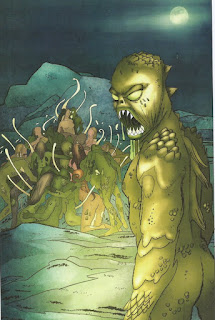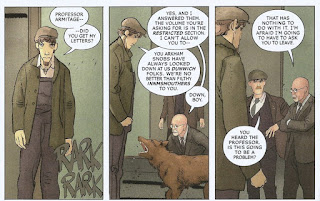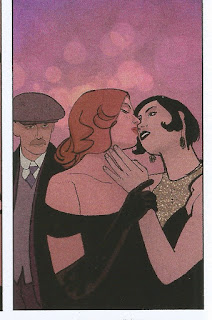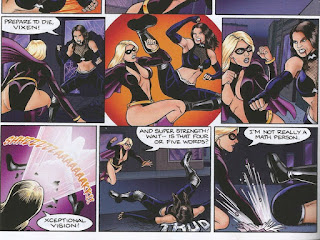Pick of the Brown Bag
February 1, 2021
by
Ray Tate
Welcome to the Pick of the Brown Bag. My name is Ray Tate, and I review the current comic books that should be available at your local comic book store. This issue is another delve into independent publishers: American Mythology, Aftershock and Ahoy. If you haven't the time for the full reviews. Check me out on Twitter: #PickoftheBrownBag.
Boy howdy! Just look at that cover. Molto bene. You get a lady with a badge in a sort of proto-punk outfit with a 1930s hairdo and a long, cool coat. Kind of a cross between an aviatrix and a police woman with Mrs. Peel attitude thrown in for good measure. Look closer at the badge, and you'll see she belongs to the FBI. Perfect.
Our mystery woman stands in front of a bulletin board filled with photos, one depicting a statue of Cthulhu. If that doesn't get the blood pumping, I don't know what will. Miskatonic is the Sucker Punch of Lovecraft-based comic books.
You may not remember Sucker Punch, since it's entirely forgettable, but I'm sure you'll remember the ad campaign.
And there were a handful more like that! Whetting the appetite. Introducing you to archetype female fighters. Like Sky Captain and the World of Tomorrow, only with more estrogen. Guess what?
When I first saw Sucker Punch, I felt I had seen one of the worst films of all time. Equal to Batman Forever. As my rage cooled and the imagery faded into a sepia haze with vague girlish faces and figures, I realized that, no, Sucker Punch wasn't a truly bad movie. Just manipulative and stupid.
The ad campaign however was resonant. The stories that burst into your head when you saw the images were all better than the story you got.
Miskatonic isn't truly bad. It's just dull and predictable. Its ad campaign, the cover of the book, is superior to the book itself. The stories bursting in your head about the vivacious Cthulhu fighter on the cover are better than what you get.
For example, no Amelia Earhart fervor.
Just plain Jane Agent Miranda Keller blackmailing her way to a plum assignment. The investigation of murder by bomb. She meets her contact, a retired NY detective Tom Malone.
They become a sort of Woolworth Avengers In a little town called Innsmouth with a group of curious and familiar looking mutants.
I swear. Miskatonic almost seems like a send-up of Lovecraft. It's one thing to be a ground-breaking Corman film like The Haunted Palace, bringing Lovecraft to the screen for the very first time.
Quite another to assume nobody reading saw that film or read the original Lovecraft work. We honestly didn't need to see the mutants hanging around.
The agents look over the scene of the crime, and writer Mark Sable throws in a little science for mostly no reason.
Oh, look! Goo!
The absence of goo at a Lovecraft crime scene would be remarkable. More important to the story, such as it is. There's this.
But how did Detective Malone find the framed photo? The art isn't very telling. One minute, he's got his hands in his pockets. The next...Presto.
Did he find the photo among the ruins? The glass isn't cracked in the frame. Was he carrying it in his coat pocket? Odd thing to do if true.
As the story goes on, and does it. The agents run afoul of the Order of Dagon and witness a fish flesh fete.
This image is neither raunchy enough nor disturbing enough to be a Lovecraft orgy of Deep Ones and mutant townsfolk. I'll never unsee the body-horror orgy in Society.
No, no, I'll not impose the visuals. This movie isn't made for newbies. As for the congress of skin and scale? Old woodcuts were more explicit, and exciting.
In the second issue, after running from the Order, our agents escape via train. Arriving at Arkham, Massachusetts, it's as though nothing from the previous night ever happened.
C'mon. You can do better than this. Most of Lovecraft's protagonists end up stark raving mad after encounters with Cthulhu and his lot.
Yes, Dagon certainly counts.
Despite all she's seen in the universe, even the Doctor winced upon seeing the villain Zellin's method of dream-theft.
Keller's blasé attitude is unbelievable. Agent Keller may be made of stronger stuff, but she should be affected by the events of the piscine pumping party in some way. Tom is at least reminded of horrific incidents in Red Hook, New York. Miranda Keller though focuses on her contempt for Tom. Whom I may add did absolutely nothing to deserve it.
Oh, and for the record, the sexual innuendo between Keller and Malone, if you want to call it that, is tiresome and juvenile, not humorous nor witty. Make it stop.
Some minor frivolity comes in the form of an unadulterated guest appearance by one of Lovecraft's greatest contributions to mad science. Just as things might become interesting, we must enter the Dunwitch Horror.
From there, we side-swipe into lesbian subtext.
Everybody likes lesbian subtext, am I right? Hell, yes, they do, but I must ask was this trip via The Conformist necessary? I don't think so. Because Sable exploits LGBT as perversion.
Aseneth Waite isn't in her right mind when seducing Miranda Keller. Whatever's possessing Waite uses her body and sensuality to lure Keller into the world of Dagon.
Keller doesn't appear to be gay. Perhaps she has some deeply buried attraction. Waite is a thrall of Dagon, so her orientation is immaterial.
Furthermore, Aseneth didn't kiss Keller into the mind-swap-control. So why must she kiss her out of mind-swap-control? Seems like desperate grandstanding to me.
Miskatonic drags the reader through Lovecraft short-stories with name checks for famous Lovecraft characters via two ordinary investigators that lack the spark of that girl on the cover.
The hit indie series with a superb concept and equally impressive artwork returns. The story is simple, and if you don't believe, me writer Tom Peyer and illustrators Jamal Igle, Roy Castro and Andy Troy explain in one page.
One of the good things about Wrong Earth is that Peyer doesn't take sides. Both gritty Dragonfly and the more innocent Dragonfly Man have admirable qualities. Dragonfly actually was the innocent Dragonfly Man until a crazed villain murdered his sidekick Stinger. He's been given a second chance with the dimensional travel.
Dragonfly's more flexible morality also allowed him to accept the offer of another crazed villain's henchwench. He didn't turn the thieving artist formerly known as Deuce into the cops. She's bad, not evil. She risked her freedom to save Stinger, when mortally wounded. She risked her life to turn against Dragonfly's nemesis the One. As a result she becomes a teammate.
One helluva teammate. Unlike Stinger, Deuce knows Dragonfly arrived from the wrong earth. She's also not into the straight-laced Dragonfly Man. He likely would have demanded that she turn herself in for her past crimes. I should point out that Dragonfly did not materialize in a television series. Lady Dragonfly's earth is just as real as Dragonfly's earth, as are the dangers.
The villains of Dragonfly Man's earth simply have more flair.
One really wonders how exactly this earth's society evolved into such a wacky reflection. No explanation is needed for Dragonfly's Earth-Omega. You may think the Adam West inspired Dragonfly Man is at a disadvantage on Earth-Omega, but both incarnations of the hero are brilliant and resourceful.
The answer is at once hilarious and impressive. Not to mention intrinsic to Dragonfly Man's insect motif. Dragonfly Man acquired the new deadly Stinger after Dragonfly discovered him amongst the riff-raff of the One's hideout. He wasn't in good shape, and Dragonfly rescued him. When Dragonfly Man appeared, he took the young man under his wing. It's been a bumpy road.
These scenes set the mood of the worlds and establish the characters, on each side of the coin. They also introduce the gist of the new series. Somebody is poisoning both earths.
The initial investigation indicates maybe both heroes can go home again, but do they want to. Dragonfly found a modicum of happiness on Earth-Alpha. Dragonfly Man is needed on Earth-Omega. Neither however belongs, yet perhaps there's a happy medium.
Sonya Devereux is an actress who takes on a number of roles in a series of Z grade to B movies. In her latest film, she becomes the superhero Violet Vixen.
So, let's get this out of the way first. This is not the most outrageously entertaining issue of Starring Sonya Devereux. Despite always being a number one, it is a series. You can find the reviews of all those absurd and damn funny past issues here. I know, I know. You know how to operate tags. Maybe you've had a rough day. Maybe you were digging out of two feet of snow. Just relax and click the link.
Starring Sonya Devereux is funny, but familiarity breeds contempt. Frankly, the superhero genre is pretty absurd to begin with. For that reason, I'm intimately up on the whole, freedom of movement argument to excuse the depiction of female flesh.
Violet Vixen's costume is actually pretty conservative when compared to any of the Legionnaire outfits from the nineteen sixties and seventies.
The introduction of Madame Midnight surprises with an actual credible costume. There may also be a nice reverb of comedy in the more modest Midnight's powers being a copy of the more hedonistic Shadow Lass' abilities.
The origin stories of VV and MM also aren't that far-fetched when compared to "belted by gamma rays" or being infused with the energy of an experimental Kree engine. Granted the science is garbage and doesn't even try to be accurate, but still.
The running gags in Sonya Devereaux however are throughout amusing. Violet Vixen is secretly a vegetarian cook influencer, which helps her survive her alien imprisonment.
Writers Nick Livingston and Nick Capetanakis also play up the tradition of secret identity blindness. Neither Violet Vixen nor the cameo champion Captain Attraction know each other's secret identities despite the flimsy disguises and their serious dating.
The best gags arise when the aliens return at an opportune moment. Their funky dialect is a riot, and their cheesy look smile-inducing, indicating the money from this production just ran out.
Still better looking than anything from Prometheus. The art by Brendon and Brian Fraim with Sarah Perryman for the important colors is top of the line. It would be welcome in any serious comic book. In fact they cannot help but treat the knock down, drag out fight with cinematography and editing that's enviable for any medium.
For fans of Sonya Devereux this is a must buy. For those that want to experience the full Sonya Devereux hilarity I recommend any of the past issues. This mild superhero spoof nevertheless is consistently amusing when not being solid superhero fare. So consider it as an auxiliary addition to the yield of your brown bag.































No comments:
Post a Comment